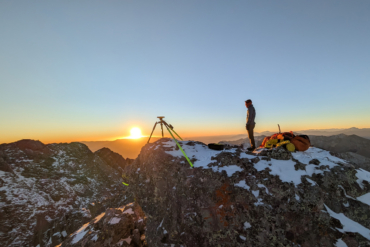Story and Photos by Sean McCoy
Rain drips from a gray sky and glints on steel bars mounted in a cold granite wall. The cliff disappears overhead in fog. I grip the metal and pull, hundreds of ladder rungs stack above forming a path up a blank face.
We are in a Norwegian valley above a fjord and climbing an unlikely route through the ruins of defunct electrical-generation system. This unique via ferrata climb on Norway’s western coast near Tyssedal shows how industrial sites of the past can become tourist attractions today.

Factories far below line an arm of the Hardangerfjord, a steely blue waterway in the district of Hardanger. Across the valley are snowcapped peaks and a glacier, now hidden by clouds.
Huge industrial pipes that once carried water from a mountain lake jut off the face of a 1,200-foot rock wall. We climb the long ladder through the ruins, an adventure experience unlike anything I’ve ever seen.
Climbers may gawk at the ethics of a permanent metal ladder on a pristine face, but this via ferrata follows a route damaged decades ago. The cliff was deflowered by industry, not mountain climbers.

Via ferrata, a term that literally means iron road, was developed by the Italian army during World War I. The metal rungs and steel cables of the via ferrata route provide both protection and access to the high face that, in the case of Lilletop Mountain, would otherwise be climbable only with aid gear and a lot of skill.
As our climb nears the summit, the rock gets steep. Vertical stone is climbed near the ruins of scaffolding used during construction and maintenance of the hydroelectric system. A portion of the climb uses an old creosote-coated wood ladder built for workers in 1906.

Scaling the rungs of wood it is easy to imagine the workers hustling up the ladder, buckets of rivets over their shoulders and tools clanging loudly. Our group, led by local guide Jostein Sodal of OpplevOdda, is outfitted simply — each man wears a Petzl helmet and harness with two short lanyards attached to locking carabiners and an ascender. This is all the gear needed for a day on the route.
Sodal explains that the region, once a thriving destination for upscale tourism, became an environmental disaster in the mid 20th century with rampant air and water pollution. Houses were painted bold colors to withstand the industrial dust, he said, and the fishery died with water pollution.

Tourists abandoned the valley for greener pastures. In the late 1980s, Tyssedal began to clean up its act. Today, the water and air are clean and tourists are gradually returning to the region. The recently-opened via ferrata offers visitors a way to experience the history and rugged beauty of the area first hand.
On our climb, we top out and find a simple wooden staircase leading to a building at the top of the mountain. Inside are the relics of the controls of the dam-watchers house, including huge valves meant to stop the flow of water to the generator 1,200 feet below.

We head through the building and into dry tunnels that once connected the tubes to a lake that fed the plant. The history lesson flows like the water that once powered the plant as we marvel at the ingenuity of past generations.
We exit the building and the sun breaks through the clouds just in time for a group picture. The valley below is green and inviting and lunch is waiting, far, far below.
—Sean McCoy is a contributing writer based in Denver. He traveled through Norway in mid-June.








